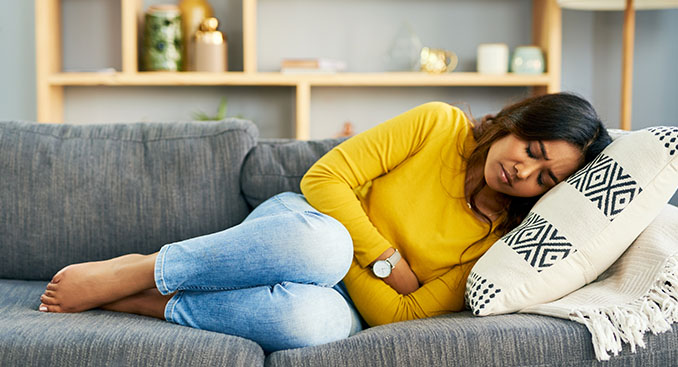- Community & News
- Conditions & Care
- Orthopedics
- Patient Stories
- Service Line
- Treatments
How to Deal With Endometriosis Symptoms

If you are a woman suffering from endometriosis, you may not know how to deal with your pain. Painful periods can ruin your week, and painful intercourse can ruin your relationship. Devin Namaky, MD, a surgeon with TriHealth Women's Services Advanced Gynecologic Surgery, explains some of the symptoms of endometriosis and shares eight ways to take control, so you can get your life back.
What are Endometriosis Symptoms?
The most common symptom of endometriosis is some form of pelvic pain, such as painful periods. You may also experience low back pain. Painful can also be debilitating.
Endometriosis can affect the bowel and bladder, causing pain with bowel movements or urination. You might experience endometriosis in a surgical scar from a prior surgery, or in rare cases, the diaphragm, chest or other area.
You may also experience abnormal bleeding, such as blood in the stool. Endometriosis can cause constant pain, but it’s also common for the pain to be cyclical and associated with your menstrual cycle.
8 Ways to Deal with Endometriosis Symptoms
1. See a Doctor
You need to be confident that endometriosis is the cause of your pain. Sometimes other causes, such as fibroids, ovarian cysts and irritable bowel syndrome can mimic the pain from endometriosis. You might also have more than one cause for your pain.
A physician can use several tools to figure out what’s going on. Pelvic ultrasound can be used to see endometriosis cysts on the ovaries, or sometimes see endometriosis of the rectum or bladder.
A gynecologist also may be able to use laparoscopy, which is a minimally invasive surgery, in order to confirm that you have endometriosis. At the same time, they can take biopsies of endometriosis tissue.
NSAID Medications
NSAID medication, such as ibuprofen or naproxen, can be helpful for endometriosis pain. This is because NSAIDs help block pathways related to endometriosis inflammation. Cox-2 inhibitors, such as celecoxib, seem to work well.
3. Hormonal Therapies
Hormonal therapy with a combination of an estrogen and progestin might be effective in controlling your endometriosis symptoms. These can be used cyclically, so you still have periods, or continuously to help eliminate periods and period symptoms. They come in pills, patches or rings, and can be combined with NSAIDs to control symptoms.
Progestin-only therapy can also be helpful for some patients who need to avoid estrogen. This can be given with pills, injections or intrauterine devices.
After starting on these hormonal therapies, many experts suggest using them for at least three months to know if they’re really working.
4. GnRH Medications with Add-back Therapy
GnRH-acting medication can also be helpful for dealing with endometriosis pain and symptoms. These come in injectable and oral forms. Side effects, such as hot flushes and bone loss, are common.
The side effects can be limited somewhat by using Add-back therapy, using a progestin called norethindrone. GnRH therapies are typically given for short-term alleviation of symptoms, for about 6-12 months.
5. Aromatase Inhibitors
There is less information available for aromatase inhibitors than for some of the other therapies. However, it seems that aromatase inhibitors, such as letrozole, can help relieve endometriosis pain.
They can cause bone loss with prolonged use and can also cause ovarian cysts. They’re given along with another medication, such as norethindrone, to suppress ovarian cyst development.
6. Accupuncture
Interestingly, there is some limited information showing acupuncture may help with painful periods in some women with endometriosis. More studies are needed, but it may be appropriate for you to discuss this treatment with your doctor.
7. Endometriosis Diet
There is currently no effective diet therapy for prevention or treatment of endometriosis. You might see information about the use of green leafy vegetables, but study information on this is poor.
8. Laparoscopic Surgery
Laparoscopy can confirm your endometriosis diagnosis or find other causes of your pain.
Laparoscopy can also be used to treat endometriosis with excision or ablation. It can provide photo documentation of endometriosis, and biopsies can be taken of the tissue. Laparoscopy can also be used to remove endometriosis cysts, or endometriomas.
Some patients with endometriosis have ovarian disease or have adenomyosis within the uterus. Laparoscopic treatment may or may not include hysterectomy or oophorectomy at the same time to treat these conditions.
Some patients who have had ovaries removed for treatment of endometriosis have pain that returns due to ovarian remnants, which are small pieces of ovary that were left behind and re-grow. These can also be removed with laparoscopic surgery.
Summary
You can take control of your endometriosis symptoms, and get relief from pelvic pain, painful periods, or painful intercourse. A physician visit is important. Several medical therapies are available, and laparoscopy can also be used.
Dr. Namaky is dedicated to helping you get your life back. He uses medical therapy and surgical excision to help relieve your pain. Most patients can either avoid surgery or go home the same day with outpatient surgery and be back to work within two weeks.
Do you have painful periods or painful sex? Has your endometriosis pain persisted despite treatment? Are you looking for a second opinion or for excision of endometriosis?
Call 513 862 1888 now for an appointment with Dr. Namaky.
Related Articles
- Conditions & Care
- Pediatrics
- Primary Care
- Service Line
- Treatments
- Conditions & Care
- Diabetes
- Disease & Symptom Information
- Patient Stories
- Service Line